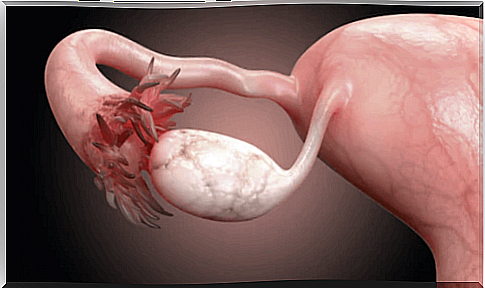Causes Of Blocked Fallopian Tubes

Blocked fallopian tubes can cause infertility in women. In fact, professionals estimate that this problem is responsible for 10 to 25% of all cases of infertility in some countries.
To understand the medical significance, it is important to note that your fallopian tubes connect the ovaries and uterus. Once blocked, the egg cannot pass from the ovaries to the uterus.
As a result, the egg and sperm cannot meet. Because of this, fertilization is impossible. The good news, however, is that in many cases this condition can be treated.
Most important symptoms of blocked fallopian tubes

An annoying aspect of this condition is that it rarely produces symptoms. In many cases, women only realize that there is a problem when they cannot get pregnant.
In some cases, however, this condition will cause mild symptoms. For example, you may experience moderate pain in one side of your abdomen. This will only happen with a type of block called hydrosalpinx.
In addition, you may experience symptoms if another problem causes this problem, such as endometriosis. In most cases, however, you will not experience any obvious symptoms as a result of blocked fallopian tubes.
What is the cause of blocked fallopian tubes?
Usually, another condition or injury is the cause of blocked fallopian tubes. Multiple health conditions can cause this problem. Here are some of the most common:
- Salpingitis. This causes inflammation of the fallopian tubes and it is the result of an infection. As the pipes are very delicate, they can become clogged or damaged.
- Hydrosalpinx. This is usually the result of an infection such as chlamydia or gonorrhea. In this case, the fimbriae at the end of the fallopian tubes are blocked. These are essential for the egg to reach the fallopian tubes from the ovary.
- Pyosalpinx. This type of inflammation occurs because there is pus in the fallopian tubes. This creates a blockage and if they rupture, they will create an abscess in the pelvis.
- Endometriosis. In this condition, part of the lining of the uterus grows outside the uterus. There may be an adhesion that is blocking the fallopian tubes.
- Pelvic surgery. This type of surgery can also lead to adhesions that can block the fallopian tubes.
- Innate. Sometimes one is born with blocked fallopian tubes.
- Blocking. This can occur if you have had surgery in the form of sterilization.
How does it affect fertility?
As we have mentioned before, blocked fallopian tubes make fertilization impossible. This blockage prevents the egg from meeting the sperm. Therefore, you can not get pregnant.
It is important to clarify the problem. Not all blockages are equally severe. There are two types:
- Total obstruction. Fertilization is impossible because the egg and sperm cannot meet.
- Partial blockage. In this case, fertilization is difficult, but not impossible. Some eggs can pass through the blockage, so it is still possible to meet the sperm.
In many cases, it is also only one fallopian tube that experiences blockage. In these situations, the egg can pass through one of the fallopian tubes. Therefore, you are less likely to get pregnant, but it is still possible.
Diagnosis of blocked fallopian tubes
In addition to the fact that the blocked fallopian tubes do not cause symptoms, they can also become unblocked. This makes a diagnosis more difficult. As a result, a specialist must perform the following examinations:
- X-ray examination. The most common option is hysterosalpingogram or HSG. The specialist will inject fluid into the fallopian tubes. Then they will take an X-ray to see if the fluid is flowing or stopping.
- Sonohysterogram. This is an ultrasound examination and it is very similar to the previous option.
- Laparoscopy. In this test, the specialist will insert a small camera into your body and examine the condition of your fallopian tubes.
A laparoscopy is the most crucial test as the other tests can result in false positive results. However, this procedure is invasive and specialists do not always recommend it. If they are not sure of the test results, they will repeat the test and supplement the results with your medical history.
Treatment

To treat blocked fallopian tubes, surgery is required. There are several types of surgeries. Your doctor will choose the one that best suits the type and location of the obstruction. In addition, they will take into account the general condition of the patient.
These are the types of operations:
- Salpingectomy. The specialist will perform this surgery if you have hydrosalpinx, which is when your fallopian tubes fill with fluid. They will do this to facilitate in vitro fertilization.
- Fimbrioplasty. Doctors will perform this operation if the part of the fallopian tube that is blocked is close to the ovary. The goal of this surgery is to rebuild the fimbriae in the fallopian tubes.
- Selective cannulation of the fallopian tubes. The specialist will choose this option if the obstruction is close to the uterus. They will insert a needle or tube into the fallopian tube to release it.
- Reanastomosis of the fallopian tubes. If the blockage is due to a disease, or if the doctor needs to transform a sterilization, he or she will use this method. It allows them to release the clogged area and connect the healthy parts.
Doctors perform this surgery using laparoscopy or open abdominal surgery. The patient must be admitted to the hospital and the recovery period varies from four to six weeks.
Possibility of pregnancy after treatment
The success of the treatment depends on the extent and location of the blockage. Your fertility will also depend on your age, your partner’s sperm quality and the extent of the damage to your fallopian tubes.
The least risky form of surgery is laparoscopy. In addition, there is always a risk of an ectopic pregnancy. This happens when the fertilized egg gets stuck outside the uterus.
Sometimes it is necessary to go through more than one procedure to treat this problem and become fertile again. Typically, you have to wait 12 to 18 months before you can see if the treatment was successful.
If the procedure is successful, most women will be able to undergo multiple pregnancies. However, if that fails, the specialist will recommend IVF or another assisted reproduction technique.
Conclusion
When a woman undergoes a surgical procedure to open her fallopian tubes, she should inform the doctor as soon as she becomes pregnant. The doctor must make sure that there is no ectopic pregnancy.
Blocked fallopian tubes will not permanently prevent you from getting pregnant. In addition, the treatment is often very successful. Finally, there are other options if it is not successful.









